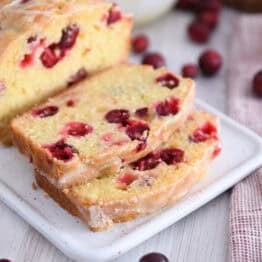
Glazed Cranberry Orange Bread
Ingredients
Bread:
- ¾ cup (160 g) granulated sugar
- 1 tablespoon fresh orange zest
- ½ cup (134 g) buttermilk (see note)
- ½ cup (100 g) neutral-flavored oil, like canola, vegetable, or grapeseed
- ¼ cup (55 g) orange juice
- 2 large (100 g) eggs
- 1 ½ cups (213 g) all-purpose flour
- 1 teaspoon baking powder
- ½ teaspoon salt
- ¼ teaspoon baking soda
- 1 ¼ cups (125 g) fresh cranberries
- 2 teaspoons all-purpose flour
Glaze:
- ¾ cup (86 g) powdered sugar
- 1 to 2 teaspoons fresh orange zest
- 1 to 2 tablespoons orange juice (see note)
Instructions
- Preheat oven to 350 degrees F. Lightly grease an 8 1/2 X 4 1/2-inch loaf pan or three mini loaf pans. If using a glass pan or dark-coated pan, reduce the oven temperature to 325 degrees F.
- For the bread, in a large bowl, add the granulated sugar and orange zest. Rub the zest into the sugar with your fingers until well-combined and fragrant.
- To the sugar mixture, add the buttermilk, oil, orange juice, and eggs. Whisk until well-combined.
- Add the flour, baking powder, salt, and baking soda. Whisk until JUST combined. It's ok if there are a few lumps and small dry streaks.
- In a small bowl, add the cranberries and spritz VERY lightly with water. I run my fingers quickly under water and then flick them over the cranberries. Add the 2 teaspoons flour and toss until the cranberries are lightly coated in flour.
- Add the cranberries to the batter and stir until evenly combined. Don't over mix.
- Pour the batter into the prepared pan(s). For a standard loaf pan, bake for 55 to 60 minutes. For mini loaf pans, bake for 28 to 30 minutes. Bake until the top of the bread springs back lightly to the touch and a toothpick inserted in the center comes out clean or with a few moist crumbs. Add time, if needed.
- While the bread bakes, make the glaze. In a medium bowl, add the powdered sugar, orange zest and 1 tablespoon of the orange juice. Whisk until combined. Continue adding orange juice a teaspoon at a time until the glaze is pourable. I prefer the glaze on the thinner side so it soaks into the bread; however, you can keep it thicker for a more pronounced glaze look on top of the bread.
- OPTION 1: When the bread is done baking, let it cool for a few minutes in the pan. Run a thin knife around the edges of the pan and turn the bread out onto a cooling rack. Let the bread cool to just warm or room temperature before glazing. Spoon the glaze over the bread. It will drizzle down the sides and pool next to the bread. You can discard the pooled glaze or continue spooning it over the bread.
- OPTION 2: Immediately out of the oven, pour about half of the glaze over the bread while still in the pan and let the bread cool in the pan for 10 to 15 minutes. Run a thin knife around the edges of the pan and remove the bread to a cooling rack. Spoon the rest of the glaze over the bread. Use this method if you want the glaze to soak into the bread a bit more.
- Cool the bread to room temperature (the glaze will set and harden as it cools). Cut into slices and serve. Store leftover bread in the refrigerator well-covered or in a sealed bag.
Notes
Oranges: You'll need about two large oranges for this recipe.
Buttermilk: This bread turns out far superior with buttermilk. I tested it with regular milk (2%), and using store bought buttermilk had the best result. Homemade buttermilk (using 1/2 milk + 1/2 sour cream or using milk with a tablespoon of lemon juice) might also work. I would recommend using 2% or whole milk for best results.
Glaze: I prefer the glaze to be on the thinner end so it soaks into the top of the bread rather than settling on top. You can make the glaze to your liking - just add less or more orange juice depending on the desired consistency. A delicious test batch I made with this bread was using orange zest and lemon juice in the glaze. A bit more bright and tart than using orange juice - the bread and glaze is super yummy either way.